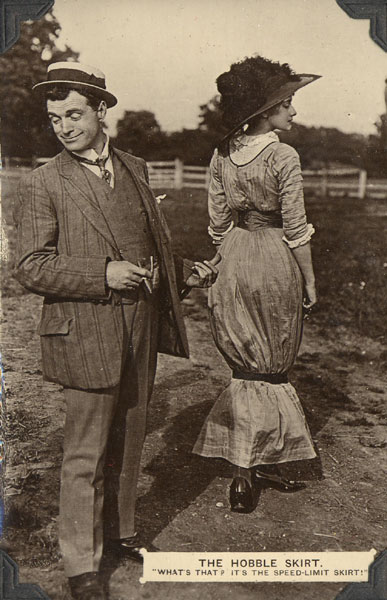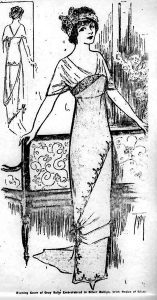

In the Milton news letter in the Milford Chronicle of October 21, 1910, correspondent David A. Conner describes a rather spectacular fall taken by a certain Miss Laura Gamble, a visitor in town. She was making her debut in a hobble skirt, and fell headlong from a porch, to her great mortification. I decided to look a little further into the short-lived fashion trend of the hobble skirt and dress, and found an astonishing number of articles and mentions in the newspapers of the day.

The hobble skirt had a hemline so narrow that the wearer could take only very short steps, as if she were bound at the ankles. The style is supposed to have been introduced in 1910 by Paul Poiret, a major French fashion designer who presided over a couture empire akin to those of Yves St. Laurent and Ralph Lauren in our own era. A story, possibly apocryphal, was printed that asserts a cartoon out of a Parisian artist’s imagination may have been the genesis of the idea. The irony of the hobble skirt is that it appeared on the fashion scene just as women were wearing looser-fitting corsets and more comfortable clothing, seeking greater freedom as they campaigned for women’s suffrage and other causes.

Many illustrations and photographs of hobble skirt wearers were tongue in cheek comments on the sillier side of the fashion, as can be seen in the first photograph of this post. There were, however, hundreds of articles and comments in newspapers and magazines about accidents, sometimes fatal, that were thought to be caused by the wearing of a hobble skirt. It was very difficult, for example, for a woman in a hobble skirt to climb the high steps of a streetcar, which was the cause of stumbles, falls, and worse. In fact, ascending and descending streetcars wearing a hobble skirt was was the most frequently cited cause of accidents related to the style. In 1911, The Pennsylvania Railroad named the wearing of hobble skirts and high heels as the principle cause of accidents to female travelers on its rail lines and in its terminals. Most women pushed back and told the railroad to stay out of their business, however. On occasion, freakish accidents were reported, such as the case of a woman crossing a footbridge in a hobble skirt, tripping, falling over the short guardrail into the river below, and drowning.
The tight, form-fitting hobble skirt was attacked by many on moral grounds; teachers complained about the length of time it took for female students to enter and leave classrooms and school buildings; and many other men and women just railed against the silliness of the fad.
The hobble skirt, which used far less material than the styles of just a few years earlier, was blamed for the woes of the textile industry in New England. Edwin Farnham Greene, treasurer of Pacific Mills on New England, alleged that a drop in demand for cloth was one reason for the closure or curtailment of operations in many textile factories in New England, resulting in strikes and social unrest.
The fashion craze ended in 1914 with the advent of the First World War. Paul Poiret enlisted in the French Army in 1914; when he returned, his fashion enterprise went bankrupt and he slid into obscurity.
Hobble skirts have resurfaced from time to time; one famous example is Morticia’s dress in the Addams Family comedy series of the 1960’s.
Sources
Lebanon Courier and Semi-Weekly Report, September 29, 1911
New Orleans Times-Democrat, May 14, 1912
Wikipedia

You have to wonder why “fashion” was so important. Reasonably intelligent women wearing garments made to highlight a silhouette even though the women can’t move.
And yes, the corset was bad … But at least it supported one’s back if properly fitted!